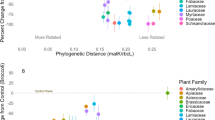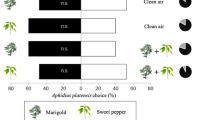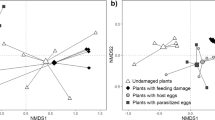Abstract
Differences in allelochemistry of plants may influence their ability to attract parasitoids.We studied responses of Diadegma semiclausum (Hellén), a parasitoid of the diamondback moth (Plutella xylostella L.), to inter- and intraspecific variation in odor blends of crucifers and a non-crucifer species. Uninfested Brussels sprout (Brassica oleracea L. gemmifera), white mustard (Sinapis alba L.), a feral Brassica oleracea, and malting barley (Hordeum vulgare L.) were compared for their attractivity to D. semiclausum in a Y-tube bioassay. Odors from all plants were more attractive to the parasitoid than clean air. However, tested against each other, parasitoids preferred the volatile blend from the three cruciferous species over that of malting barley.Wasps also discriminated between uninfested crucifers: mustard was as attractive as feral B. oleracea, and both were more attractive than Brussels sprout. Attractivity of uninfested plants was compared with that of plants infested by larvae of the host P. xylostella. Host-infested mustard and Brussels sprout were more attractive than uninfested conspecifics. Interestingly, the volatile blends of uninfested white mustard and infested Brussels sprout were equally attractive.We also compared the volatile composition of different plant sources by collecting headspace samples and analysing them with GC-MS. Similarities of volatile profiles were determined by hierarchic clustering and non-metric scaling based on the Horn-index. Due to the absence of several compounds in its blend, the volatile profile of barley showed dissimilarities from blends of crucifers. The odor profile of white mustard was distinctly different from the two Brassicaceae.Feral Brassica oleracea odor profile was different from infested Brussels sprout, but showed overlap with uninfested Brussels sprout. Odor blends from infested and uninfested Brussels sprout were similar, and mainly quantitative differences were found. D. semiclausum appears to discriminate based on subtle differences in volatile composition of odor blends from infested and uninfested plants.
Similar content being viewed by others
References
N. G. AGELOPOULOS and KELLER, M. A. 1994. Plant-natural enemy association in the tritrophic system, Cotesia rubecula-Pieris rapae-Brassiceae (Cruciferae): III. Collection and identification of plant and frass volatiles. J. Chem. Ecol. 20:1955–1967.
AGELOPOULOS, N. G., DICKE, M., and POSTHUMUS, M. A. 1995. Role of volatile infochemicals emitted by feces of larvae in host-searching behavior of parasitoid Cotesia rubecula (Hymenoptera: Braconidae): a behavioural and chemical study. J. Chem. Ecol. 21:1789–1811.
BENREY, B., CALLEJAS, A., RIOS, L., OYAMA, K., and DENNO, R. F. 1998. The effects of domestication of Brassica and Phaseolus on the interaction between phytophagous insects and parasitoids. Biol. Control. 11:130–140.
BIGGER, D. S. and FOX, L. R. 1997. High-density populations of diamondback moth have broader host-plant diets. Oecologia. 112:179–186.
A. BLAAKMEER, GEERVLIET, J. B. F., VAN LOON, J. J. A., POSTHUMUS, M. A., VAN BEEK, T. A., and DE GROOT, A. E. 1994. Comparative headspace analysis of cabbage plants damaged by two species of Pieris caterpillars: consequences for in-flight host location by Cotesia parasitoids. Entomol. Exp. Appl. 73:175–182.
DE BOER, J. G. 2004. Bugs in odour space; How predatory mites respond to variation in herbivore-induced plant volatiles. Ph.D. dissertation. Wageningen University, Ponsen & Looijen BV, The Netherlands.
BOTTRELL, D. G., BARBOSA, P., and GOULD, F. 1998. Manipulating natural enemies by plant variety selection and modification: a realistic strategy? Annu. Rev. Entomol. 43:347–367.
BOTTRELL, D. G., BARBOSA, P., and GOULD, F. 1998. Manipulating natural enemies by plant variety selection and modification: a realistic strategy? Annu. Rev. Entomol. 43:347–367.
BUKOVINSZKY, T. 2004. Tailoring complexity; multitrophic interactions in simple and diversified habitats. Ph.D. dissertation. Wageningen University, Ponsen & Looijen BV, The Netherlands.
CORTESERO, A. M., STAPEL, J. O., and LEWIS, W. J. 2000. Understanding and manipulating plant attributes to enhance biological control. Biol. Control. 17:35–49.
CORTESERO, A. M., STAPEL, J. O., and LEWIS, W. J. 2000. Understanding and manipulating plant attributes to enhance biological control. Biol. Control. 17:35–49.
DICKE, M. 1999. Direct and indirect effects of plants on performance of beneficial organisms, pp. 105–153, in J.R. Ruberson, (ed.) Handbook of Pest Management. Marcel Dekker Inc., New York.
G. W. ELZEN, WILLIAMS, H. J., and VINSON, S. B. 1983. Response by the parasitoid Campoletis sonorensis (Hymenoptera: Ichneumonidae) to synomones in plants: Implications for host habitat location. Environ. Entomol. 12:1873–1877.
ELZEN, G. W., WILLIAMS, H. J., and VINSON, S. B. 1986. Wind tunnel flight response by hymenopterous parasitoid Campoletis sonorensis to cotton cultivars and lines. Entomol. Exp. Appl. 42:285–289.
FOX, L. R. and EISENBACH, J. 1992. Contrary choices: possible exploitation of enemy-free space by herbivorous insects in cultivated vs. wild crucifers. Oecologia. 89:574–579.
FOX, L. R. and EISENBACH, J. 1992. Contrary choices: possible exploitation of enemy-free space by herbivorous insects in cultivated vs. wild crucifers. Oecologia. 89:574–579.
GEERVLIET, J. B. F., VET, L. E. M., and DICKE, M. 1996. Innate responses of the parasitoids Cotesia glomerata and C. rubecula (Hymenoptera: Braconidae) to volatiles from different plant-herbivore complexes. J. Insect. Behav. 9:525–538.
GEERVLIET, J. B. F., VET, L. E. M., and DICKE, M. 1996. Innate responses of the parasitoids Cotesia glomerata and C. rubecula (Hymenoptera: Braconidae) to volatiles from different plant-herbivore complexes. J. Insect. Behav. 9:525–538.
GOUINGUENÉ, S., DEGEN, T., and TURLINGS, T. C. J. 2001. Variability in herbivore-induced odour emissions among maize cultivars and their wild ancestors (teosinte). Chemoecology. 11:9–16.
GOUINGUENÉ, S., DEGEN, T., and TURLINGS, T. C. J. 2001. Variability in herbivore-induced odour emissions among maize cultivars and their wild ancestors (teosinte). Chemoecology. 11:9–16.
HARVEY, J. A., VAN DAM, N. M., and GOLS, R. 2003. Interactions over four trophic levels: foodplant quality affects development of a hyperparasitoid as mediated through a herbivore and its primary parasitoid. J. Anim. Ecol. 72:520–531.
HARVEY, J. A., VAN DAM, N. M., and GOLS, R. 2003. Interactions over four trophic levels: foodplant quality affects development of a hyperparasitoid as mediated through a herbivore and its primary parasitoid. J. Anim. Ecol. 72:520–531.
KALULE, T. and WRIGHT, D. J. 2004. The influence of cultivar and cultivar-aphid odours on the olfactory response of the parasitoid Aphidius colemani. J. Appl. Entomol. 128:120–125.
KREBS, C. J. 1989. Niche overlap and diet analysis. pp. 654, in C. J. Krebs (ed.). Ecological Methodology. Harper Collins Publishers, Inc.
LIU, S. S. and JIANG, L. H. 2003. Differential parasitism of Plutella xylostella (Lepidoptera: Plutellidae) larvae by the parasitoid Cotesia plutellae (Hymenoptera: Braconidae) on two host plant species. Bull. Entomol. Res. 93:65–72.
LOUGHRIN, J. H., MANUKIAN, A., HEATH, R. R., and TUMLINSON, J. K. 1995. Volatiles emitted by different cotton varieties damaged by feeding beet armyworm larvae. J. Chem. Ecol. 21:1217–1227.
LOUGHRIN, J. H., MANUKIAN, A., HEATH, R. R., and TUMLINSON, J. K. 1995. Volatiles emitted by different cotton varieties damaged by feeding beet armyworm larvae. J. Chem. Ecol. 21:1217–1227.
MCCLOSKEY, C. and ISMAN, M. B. 1993. Influence of foliar glucosinolates in oilseed rape and mustard on feeding and growth of the bertha armyworm, Mamestra configurata Walker. J. Chem. Ecol. 19:249–266.
MEWIS, I., ULRICH, C. H., and SCHNITZLER, W. H. 2002. The role of glucosinolates and their hydrolysis products in oviposition and host-plant finding by cabbage webworm, Hellula undalis. Entomol. Exp. Appl. 105: 129–139.
MEWIS, I., ULRICH, C. H., and SCHNITZLER, W. H. 2002. The role of glucosinolates and their hydrolysis products in oviposition and host-plant finding by cabbage webworm, Hellula undalis. Entomol. Exp. Appl. 105: 129–139.
OHARA, Y., TAKAFUJI, A., and TAKABAYASHI, J. 2003. Response to host-infested plants in females of Diadegma semiclausum Hellen (Hymenoptera: Ichneumonidae). Appl. Entomol. Zool. 38:157–162.
S. J. OPPENHEIM and GOULD, F. 2002. Behavioural adaptations increase the value of enemy-free space for Heliothis subflexa, a specialist herbivore. Evolution. 56:679–689.
PALANISWAMY, P., GILLOT, C., and SLATER, G. P. 1986. Attraction of diamondback moths, Plutella xylostella (L.) (Lepidoptera: Plutellidae), by volatile compounds of canola, white mustard, and faba bean. Can. Entomol. 118:1279–1285.
PODANI, J. 1997. Bevezetés a többváltozós biológiai adatfeltárás rejtelmeibe. [Introduction to the multivariate analysis of biological data.] Scientia Kiado, Budapest.
R. P. J. POTTING, POPPY, G. M., and SCHULER, T. H. 1999. The role of volatiles from cruciferous plants and pre-flight experience in the foraging behaviour of the specialist parasitoid Cotesia plutellae. Entomol. Exp. Appl. 93:87–95.
READ, D. P., FEENY, P. P., and ROOT, R. B. 1970. Habitat selection by the aphid parasite Diaeretiella rapae (Hymenoptera: Braconidae) and hyperparasite Charips brassicae (Hymenoptera: Cynipidae). Can. Entomol. 102:1567–1578.
REDDY, G. V. P. and GUERRERO, A. 2000. Behavioural responses of the diamondback moth to green leaf volatiles of Brassica oleracea subsp. capitata. J. Agric. Food Chem. 48:6025–6029.
REDDY, G. V. P. and GUERRERO, A. 2000. Behavioural responses of the diamondback moth to green leaf volatiles of Brassica oleracea subsp. capitata. J. Agric. Food Chem. 48:6025–6029.
REED, H. C., TAN, S. H., HAAPENEN, K., KILLMON, M., REED, D. K., and ELLIOT, N. C. 1985. Olfactory responses of the parasitoid Diaeretiella rapae (Hymenoptera: Aphididae) to odour of plants, aphids, and aphid-plant complexes. J. Chem. Ecol. 21:407–418.
SHIOJIRI, K., TAKABAYASHI, J., YANO, S., and TAKAFUJI, A. 2000. Flight response of parasitoids toward plant-herbivore complexes: A comparative study of two parasitoid-herbivore systems on cabbage plants. Appl. Entomol. Zool. 35:87–92.
SHIOJIRI, K., TAKABAYASHI, J., YANO, S., and TAKAFUJI, A. 2001. Infochemically mediated tritrophic interaction webs on cabbage plants. Popul. Ecol. 43:23–29.
H. M. SMID, VAN LOON, J. J. A., POSTHUMUS, M. A., and VET, L. E. M. 2002. GC-EAG-analysis of volatiles from Brussels sprouts plants damaged by two species of Pieris caterpillars: olfactory receptive range of a specialist and a generalist parasitoid wasp species. Chemoecology. 12:169–176.
STEINBERG, S., DICKE, M., and VET, L. E. M. 1993. Relative importance of infochemicals from first and second trophic level in long-range host location by the larval parasitoid Cotesia glomerata. J. Chem. Ecol. 19:47–60.
STEINBERG, S., DICKE, M., VET, L. E. M., and WANNINGEN, R. 1992. Response of the braconid parasitoid Cotesia (=Apanteles) glomerata to volatile infochemicals: effect of bioassay set-up, parasitoid age and experience and barometric flux. Entomol. Exp. Appl. 63:163–175.
STEINBERG, S., DICKE, M., VET, L. E. M., and WANNINGEN, R. 1992. Response of the braconid parasitoid Cotesia (=Apanteles) glomerata to volatile infochemicals: effect of bioassay set-up, parasitoid age and experience and barometric flux. Entomol. Exp. Appl. 63:163–175.
TAKABAYASHI, J., DICKE, M., and POSTHUMUS, M. A. 1994. Volatile herbivore-induced terpenoids in plant mite interactions: variation caused by biotic and abiotic factors. J. Chem. Ecol. 20:1329–1354.
TAKABAYASHI, J., NODA, T., and TAKAHASHI, S. 1991. Plants produce attractants for Apanteles kariyai, a parasitoid of Pseudaletia separate: cases of “communication” and “misunderstanding” in parasitoid-plant interactions. Appl. Entomol. Zool. 26:237–243.
TAKABAYASHI, J., NODA, T., and TAKAHASHI, S. 1991. Plants produce attractants for Apanteles kariyai, a parasitoid of Pseudaletia separate: cases of “communication” and “misunderstanding” in parasitoid-plant interactions. Appl. Entomol. Zool. 26:237–243.
TOLLSTEN, L. and BERGSTRÖM, G. 1988. Headspace volatiles of whole plants and macerated plant parts of Brassica and Sinapis. Phytochemistry. 27:4013–4018.
J. H. TUMLINSON, TURLINGS, T. C. J., and LEWIS, W. J. 1993. Semiochemically mediated foraging behavior in beneficial parasitic insects. Arch. Insect Biochem. 22:385–391.
VAN LENTEREN, J. C., ZHAO, L. H., KAMERMAN, J. W., and XU, R. 1995. The parasite-host relationship between Encarsia formosa (Hym., Aphelinidae) and Trialeurodes vaporariorum (Hom., Aleyrodidae).26. Leaf hairs reduce the capacity of Encarsia to control greenhouse whitefly on cucumber. J. Appl. Entomol. 119:553–559.
VET, L. E. M. 1999. Evolutionary aspects of plant-carnivore interactions, pp. 3–13, in D. J. Chadwick and J. A. Goode (eds.). Insect-Plant Interactions and Induced Plant Defence; Wiley, Chicester.
L. E. M. VET and DICKE, M. 1992. Ecology of infochemical use by natural enemies in a titrophic context. Annu. Rev. Entomol. 37:141–172.
VET, L. E. M., DE JONG, A. G., FRANCHI, E., and PAPAJ, D. R. 1998. The effect of complete vs incomplete information on odour discrimination in a parasitic wasp. Anim. Behav. 55:1271-1279.
L. E. M. VET, WÄCKERS, F., and DICKE, M. 1991. How to hunt for hiding hosts: the reliability-detectability problem in foraging parasitoids. Neth. J. Zool. 41:202–213.
VINSON, S. B. 1976. Host selection by insect parasitoids. Annu. Rev. Entomol. 21:109–133.
VÖLKL, W. and SULLIVAN, D. J. 2000. Foraging behaviour, host plant and host location in the aphid hyperparasitoid Euneura augarus. Entomol. Exp. Appl. 97:47–56.
S. YANO 1994. Ecological and evolutionary interactions between wild crucifers and their herbivorous insects. Plant Spec. Biol. 9:137–143.
Author information
Authors and Affiliations
Corresponding author
Rights and permissions
About this article
Cite this article
Bukovinszky, T., Gols, R., Posthumus, M.A. et al. Variation In Plant Volatiles and Attraction Of The ParasitoidDiadegma semiclausum(Hellén). J Chem Ecol 31, 461–480 (2005). https://doi.org/10.1007/s10886-005-2019-4
Received:
Accepted:
Issue Date:
DOI: https://doi.org/10.1007/s10886-005-2019-4




